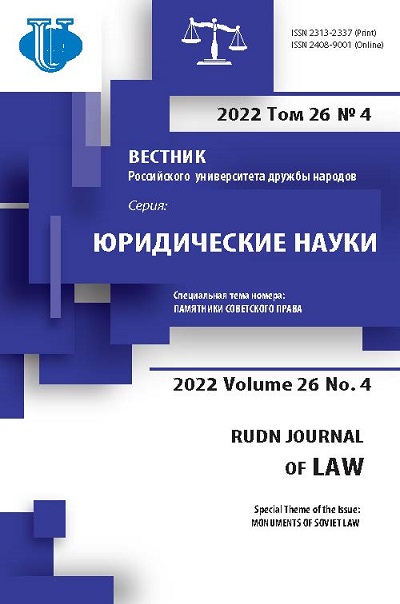Верховный Суд РСФСР как правовая форма верховной судебной власти: к 100-летию Верховного Суда Российской Федерации
- Авторы: Бурдина Е.В.1, Фомина Л.Ю.1
-
Учреждения:
- Российский государственный университет правосудия
- Выпуск: Том 26, № 4 (2022): ПАМЯТНИКИ СОВЕТСКОГО ПРАВА
- Страницы: 808-825
- Раздел: СОВЕТСКИЙ СОЮЗ В РЕТРОСПЕКТИВЕ СОВРЕМЕННОЙ ЮРИДИЧЕСКОЙ НАУКИ
- URL: https://journals.rudn.ru/law/article/view/32970
- DOI: https://doi.org/10.22363/2313-2337-2022-26-4-808-825
- ID: 32970
Цитировать
Аннотация
100-летний юбилей высшего судебного органа России обусловил актуальность изучения Верховного Суда РСФСР как историко-правового феномена, сформированного в качестве высшего звена на принципиально иных, нежели ранее, организационных подходах. Исследуется специфика высшего звена российской судебной системы, включая правовые формы организации и деятельности Верховного Суда РСФСР, структурные внутрисистемные взаимосвязи, место и роль в развитии российской государственности. Проводится анализ теоретических концепций и судоустройственного законодательства на протяжении между двумя судебными реформами (1864 и 1922 гг.). Цель исследования: раскрытие особенностей правовой модели Верховного Суда РСФСР 1922 г. как впервые созданной национальной формы организационно автономного суда высшей судебной инстанции в контексте его места и роли в системе советской юстиции. Методология исследования основана на сравнительно-правовом и историко-правовом подходах. При написании статьи использовались не только правовые акты, но и публикации партийных и советских деятелей первых лет советской власти, посвященные проблемам формирования единой судебной системы и ее высшего органа. Выделяются предпосылки образования Верховного Суда РСФСР, связанные с запросами на стабильность и ясность правопорядка, единство судебной практики в условиях НЭПа. Сделаны выводы, касающиеся правового положения Верховного Суда РСФСР, выделяются его признаки как высшего звена в единой судебной системе, определяется правовая природа, место и роль в системе органов юстиции, где Верховный Суд был наделен организационно-управленческими полномочиями в отношении народных следователей, коллегий защитников, судебных исполнителей и государственных нотариальных контор.
Об авторах
Елена Владимировна Бурдина
Российский государственный университет правосудия
Автор, ответственный за переписку.
Email: elenburdina@yandex.ru
ORCID iD: 0000-0001-5431-7634
доктор юридических, доцент, заведующий кафедры организации судебной и правоохранительной деятельности
Российская Федерация, 117418, г. Москва, ул. Новочеремушкинская, д. 69Лилия Юрьевна Фомина
Российский государственный университет правосудия
Email: fominalilja@mail.ru
ORCID iD: 0000-0002-4273-2280
кандидат юридических наук, доцент кафедры организации судебной и правоохранительной деятельности
Российская Федерация, 117418, г. Москва, ул. Новочеремушкинская, д. 69Список литературы
- Абдулин Р.С. Судебное управление в Российской Федерации (1917-1990). Историко-юридическое исследование. М.: Юрлитинформ, 2014. 360 с.
- Бондаренко А.В. Судебная система РСФСР в условиях НЭПа: дис. … канд. юрид. наук М.: Учреждение Российской академии наук Института государства и права РАН, 2010. 156 с.
- Черлюнчакевич Н. Задачи нашего IV Всероссийского Съезда // Еженедельник Советской юстиции. 1922. № 1. С. 3-4.
- Филонова О. И. Значение юридической периодики в проведении судебной реформы в России: историко-правовой анализ (на материалах «Еженедельника Советской Юстиции») // Российский судья. 2020. № 5. С. 49-54. https://doi.org/10.18572/1812-3791-2020-5-49-54
- Гогель С.К. Правительствующий сенат в XIX столетии: Компетенция. Делопроизводство. Уголовный процесс. Охранение прав личности. СПб.: Сенат. тип., 1911. 208 с.
- Голунский С.А., Карев Д.С. Лекции по судоустройству. М.: Юрид. изд-во НКЮ СССР, 1939. 209 с.
- Гойхбарг А. Наша экономика и право // Еженедельник Советской юстиции. 1922. № 19/20. С. 1-4.
- Гришковец А.А. Органы государственного управления: сущность и компетенция // Труды Института государства и права Российской академии наук. 2015. № 4. С. 56-79.
- Ильина Т. Н. Организация верховного правосудия в РСФСР в 1920-е годы: поиск оптимальной модели // Историко-правовые проблемы: Новый ракурс. 2017. № 2. С. 63-75.
- Кожевников М.В. История советского суда. 1917-1947 гг. М.: Юрид. изд-во НКЮ СССР, 1948. 376 с.
- Краковский К.П. История суда и правосудия в России: в 9 т. Т. 4: Судоустройство и судопроизводство в России периода судебных реформ (1864-1881 годы): монография / отв. ред. В.М. Сырых. М.: Норма, 2019. 672 с.
- Крыленко Н.В. Реформа судоустройства // Еженедельник советской юстиции. 1922. № 37-38. С. 1-5.
- Курский Д. Ближайшие задачи Народного Комиссариата Юстиции // Еженедельник Советской юстиции. 1922. № 1. С. 3.
- Кутафин О.Е., Лебедев В.М., Семигин Г.Ю. Судебная власть в России: история, документы: в 6 т. Т. V. Советское государство / отв. ред. Р.С. Мулукаев, А.Я. Малыгин. М.: Мысль, 2003. 829 с.
- Лезов И.Л. Советский суд в 1917-1940 гг.: дис. … канд. юрид. наук. М., 1998. 165 с.
- Лисицын А. Судебная реформа // Еженедельник Советской юстиции. 1922. № 33. С. 1-2.
- Лунин А. Две ударные задачи // Еженедельник советской юстиции. 1922. № 19/20. С. 4-5.
- Павлов В.А. Становление органов юстиции и прокуратуры РСФСР: Октябрь 1917 г. - декабрь 1922 г.: дис. … канд. юрид. наук: 07.00.02. М., 2004. 174 с.
- Петухов Н.А. История военных судов России / под ред., с предисл.: Лебедев В.М. М.: Норма, 2003. 352 c.
- Портнов В.П., Славин М.М. Становление правосудия Советской России (1917-1922) / отв. ред. С. В. Боботов. М.: Наука, 1990. 165 с.
- Смыкалин А.С. История судебной системы России: учебное пособие. М.: ЮНИТИ-ДАНА: Закон и право, 2010. 231 с.
- Соколов Д.В. Эволюция структуры и функций Правительствующего Cената в Российской империи (1711-1917 гг.): историко-правовое исследование / под ред. А.А. Демичева. М.: Юрлитинформ, 2020. 179 с.
- Титков В.И. Революционные трибуналы как органы политической борьбы // Судебная власть и уголовный процесс. 2017. № 3. С. 71-83.
- Захаров В.В. Высший судебный контроль в РСФСР // Историко-правовые проблемы: Новый ракурс. 2016. Вып. 15. С. 47-114.
Дополнительные файлы















